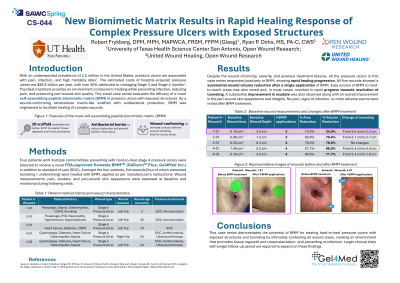Case Series/Study
(CS-044) New Biomimetic Matrix Results in Rapid Healing Response of Complex Pressure Ulcers with Exposed Structures
Friday, May 2, 2025
7:45 PM - 8:45 PM East Coast USA Time

Ryan Dirks, MS, PA-C, CWS – United Wound Healing; Open Wound Reseacrh
Introduction: With an underreported prevalence of 2.5 million in the United States, pressure ulcers are associated with pain, infection, and high mortality rates1. The estimated costs of hospital-acquired pressure ulcers are $26.8 billion per year, with over 50% attributed to managing Stage 3 and Stage 4 injuries1. The ideal treatment provides an environment conducive to healing while preventing infection, reducing pain, and preserving peri-wound skin quality. This small case series evaluates the efficacy of a novel self-assembling peptide biomimetic matrix (BMM) in pressure ulcers with exposed structures. As a wound-conforming extracellular matrix-like scaffold with antibacterial protection, BMM was engineered to facilitate healing of complex wounds.
Methods: Four patients with multiple comorbidities presenting with chronic ( > 2 months) Stage 4 pressure ulcers were selected to receive a novel FDA-approved flowable BMM*, in addition to standard of care. Three out of the four ulcers (75%) presented tunnels and/or undermined areas. Wound measurements, pain, and peri-wound skin appearance were assessed at baseline and monitored during following visits
Results: All patients responded positively to BMM treatment, showing rapid wound depth reduction and wound healing progression. In two cases, rapid wound closure was observed, with > 70% area reduction achieved after a single BMM application and healthy granulation tissue formation. In two other cases, while there was no marked reduction in wound surface area within the first one to two applications, a substantial wound depth reduction with granulation tissue formation was observed. Easy access of BMM to hard-to-reach areas was also noted and resulted in rapid progress towards resolution of tunneling / undermining. In all four cases, the post-BMM treatment visits recorded no pain, no signs of infection, and intact peri-wound skin with healthy skin appearance. No adverse events were observed.
Discussion: This small case series demonstrates the potential of BMM for treating chronic, complex pressure ulcers with exposed structures and tunneling or undermining by intimately contacting all wound areas, creating an environment that promotes tissue regrowth and revascularization, and preventing re-infection. Larger clinical trials with longer follow-up period are required to expand on these findings.
Methods: Four patients with multiple comorbidities presenting with chronic ( > 2 months) Stage 4 pressure ulcers were selected to receive a novel FDA-approved flowable BMM*, in addition to standard of care. Three out of the four ulcers (75%) presented tunnels and/or undermined areas. Wound measurements, pain, and peri-wound skin appearance were assessed at baseline and monitored during following visits
Results: All patients responded positively to BMM treatment, showing rapid wound depth reduction and wound healing progression. In two cases, rapid wound closure was observed, with > 70% area reduction achieved after a single BMM application and healthy granulation tissue formation. In two other cases, while there was no marked reduction in wound surface area within the first one to two applications, a substantial wound depth reduction with granulation tissue formation was observed. Easy access of BMM to hard-to-reach areas was also noted and resulted in rapid progress towards resolution of tunneling / undermining. In all four cases, the post-BMM treatment visits recorded no pain, no signs of infection, and intact peri-wound skin with healthy skin appearance. No adverse events were observed.
Discussion: This small case series demonstrates the potential of BMM for treating chronic, complex pressure ulcers with exposed structures and tunneling or undermining by intimately contacting all wound areas, creating an environment that promotes tissue regrowth and revascularization, and preventing re-infection. Larger clinical trials with longer follow-up period are required to expand on these findings.

.jpg)